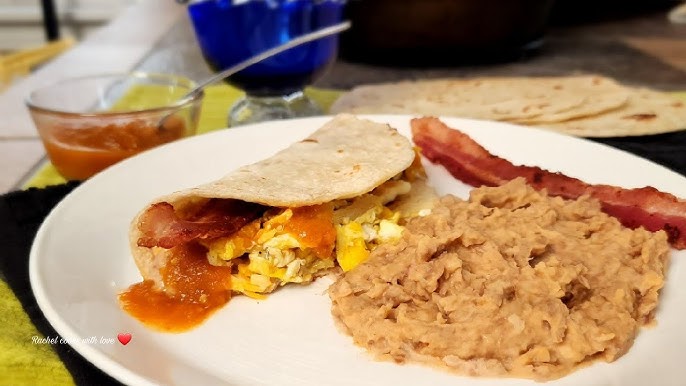Refried Beans Recipe: Refried beans are a staple in Mexican cuisine, loved for their rich, creamy texture and robust flavor. These beans make a great accompaniment to popular dishes like tacos, enchiladas, and burritos. However, making refried beans at home brings out a fresh flavor you won’t get from canned beans. Despite the name, refried beans aren’t actually fried twice; instead, they’re cooked until tender, mashed, and then cooked again in a small amount of fat or oil to enhance their taste and texture.
This step-by-step guide will take you through everything you need to know to make delicious refried beans at home, from choosing the right beans to mastering the perfect consistency. Ready to dive in? Let’s get cooking!
Ingredients for Refried Beans
To make authentic refried beans, you’ll need just a handful of ingredients:
- Beans: Traditionally, pinto beans are used, but black beans are also a popular alternative.
- Cooking Fat: Lard is used in traditional recipes, but you can substitute it with vegetable oil, butter, or bacon grease for added flavor.
- Salt and Pepper: Basic seasoning to bring out the beans’ natural flavors.
- Optional Seasonings: Cumin, garlic, and chili powder can add extra depth and warmth to the beans.
- Water or Broth: Using broth instead of water can enhance the beans’ flavor, making them even more savory.
Tools You’ll Need
- Large Pot: For boiling the beans until tender.
- Colander or Strainer: To drain the beans after cooking.
- Skillet or Frying Pan: For the final frying step.
- Potato Masher or Fork: To mash the beans to the desired consistency.
- Ladle: To add water or broth as needed during the frying step.
Step-by-Step Refried Beans Recipe
Step 1: Prepare and Soak the Beans
Start by rinsing the beans to remove any dirt or small stones. Once cleaned, you have two options for soaking:
- Overnight Soak: Place the beans in a large bowl, cover with water (at least 2-3 inches above the beans), and let them soak overnight. This helps soften the beans and speeds up cooking time.
- Quick Soak: For a faster option, place the beans in a pot, cover with water, bring to a boil, and let them cook for 2 minutes. Remove from heat, cover, and let the beans soak for 1 hour.
Soaking helps reduce cooking time and makes the beans easier to digest by removing some of the natural sugars that can cause gas.
Step 2: Cook the Beans
After soaking, drain the beans and transfer them to a large pot. Cover them with fresh water or broth, then bring to a boil over medium-high heat. Once boiling, reduce the heat and let the beans simmer until tender—about 1.5 to 2 hours, depending on the bean type and age. Keep an eye on the water level, adding more if needed to prevent burning.
For quicker results, you can use a pressure cooker or Instant Pot. Cook the beans for about 25 minutes on high pressure with a natural release. This method saves time and achieves the same tender texture.
Step 3: Drain and Mash the Beans
Once the beans are cooked, drain them using a colander, reserving a bit of the cooking liquid. You’ll use this liquid later to adjust the beans’ consistency. Return the beans to the pot or a bowl and mash them with a potato masher or fork. Aim for a texture that’s mostly smooth but still has some whole beans for added texture. If you prefer ultra-smooth beans, use an immersion blender or food processor.
Step 4: Frying the Beans with Seasoning
Heat a skillet over medium heat and add 2-3 tablespoons of fat (lard, oil, or butter). Once the fat is hot, add the mashed beans and spread them out in the pan. Add your choice of seasonings—garlic powder, cumin, and chili powder are all excellent choices. Stir the beans continuously to prevent them from sticking to the pan, and let them cook for about 5-7 minutes, until they’re creamy and heated through.
If the beans become too thick, gradually add small amounts of the reserved cooking liquid or additional water/broth. Adjust the seasonings to taste, adding salt and pepper as needed.
Step 5: Adjusting the Consistency
The consistency of refried beans is a personal preference. If you like them on the thicker side, allow them to cook longer to reduce the liquid. For creamier beans, add more cooking liquid or broth and stir well to incorporate. The beans will thicken slightly as they cool, so take that into account when adjusting the texture.
Additional Flavor Variations
Enhance your refried beans by adding extra flavors, such as:
- Onions and Garlic: Sauté finely chopped onions and garlic in the oil before adding the beans for a richer taste.
- Spicy Peppers: Add chopped jalapeños or serrano peppers for a spicy kick.
- Cheese: Stir in some shredded cheese for a creamy, cheesy finish.
Experiment with spices like smoked paprika, oregano, or even a dash of hot sauce for a personalized touch.
Serving Suggestions
Refried beans can be served in various ways:
- As a Side Dish: Perfect alongside rice, grilled meats, or tacos.
- Inside Burritos or Tacos: Spread on tortillas or add them as a filling with meat and veggies.
- Topped with Cheese and Salsa: Serve as a dip with tortilla chips for an appetizer or snack.
Storage Tips
Refried beans can be stored in an airtight container in the refrigerator for up to 4 days. For longer storage, freeze them in small portions for up to 3 months. Thaw in the refrigerator overnight and reheat on the stove, adding a bit of water if needed to reach the desired consistency.
Nutritional Benefits of Refried Beans
Beans are a great source of plant-based protein, fiber, and essential nutrients like iron, magnesium, and folate. They are low in fat, especially if made without lard, and can be a nutritious addition to any meal. Refried beans provide a filling, satisfying side while being packed with vitamins and minerals.
Common Mistakes to Avoid
- Using Canned Beans Without Rinsing: Canned beans are often salty and should be rinsed to reduce sodium content before cooking.
- Burning the Beans: Stir constantly during the frying step to prevent sticking.
- Over-Salting: Taste as you go, especially if you use broth, which can add saltiness.
Refried Beans Recipe for a Crowd
To make a larger batch, double or triple the recipe. Be sure to use a large enough pot to cook the beans evenly, and adjust seasoning to taste.
FAQs about Refried Beans Recipe
Q: What are refried beans?
A: Refried beans are a classic Mexican dish made by mashing cooked beans, typically pinto or black beans, and then frying them in oil or lard with seasonings. They’re popular as a side dish or filling in tacos, burritos, and other Tex-Mex recipes.
Q: Are refried beans healthy?
A: Yes, refried beans can be healthy when prepared with minimal oil or lard and without added preservatives. They’re high in protein, fiber, and essential nutrients. For a healthier version, use olive oil instead of lard and opt for low-sodium seasonings.
Q: Can I make refried beans from canned beans?
A: Absolutely! Canned beans can be used to save time. Drain and rinse the beans before mashing and frying them to reduce sodium. Add spices like cumin, garlic, and chili powder for extra flavor.
Q: How do I make refried beans creamy?
A: For a creamy texture, mash the beans well and add a bit of water or broth while cooking. You can also blend a portion of the beans before frying for an extra smooth consistency.
Q: How long do homemade refried beans last?
A: Store homemade refried beans in an airtight container in the refrigerator for up to 4 days. They can also be frozen for up to 3 months. Reheat on the stove with a splash of water to retain their creamy texture.
Conclusion
Making refried beans from scratch is a rewarding process that brings rich, authentic flavor to your meals. By following this guide, you can master the art of creating perfectly creamy, savory beans that enhance any dish.
From soaking and cooking to frying and seasoning, each step allows you to tailor the taste and texture to your liking. Try this recipe next time you’re preparing a Mexican feast, and enjoy the fresh, homemade difference!



